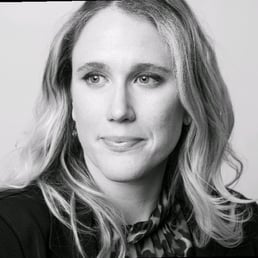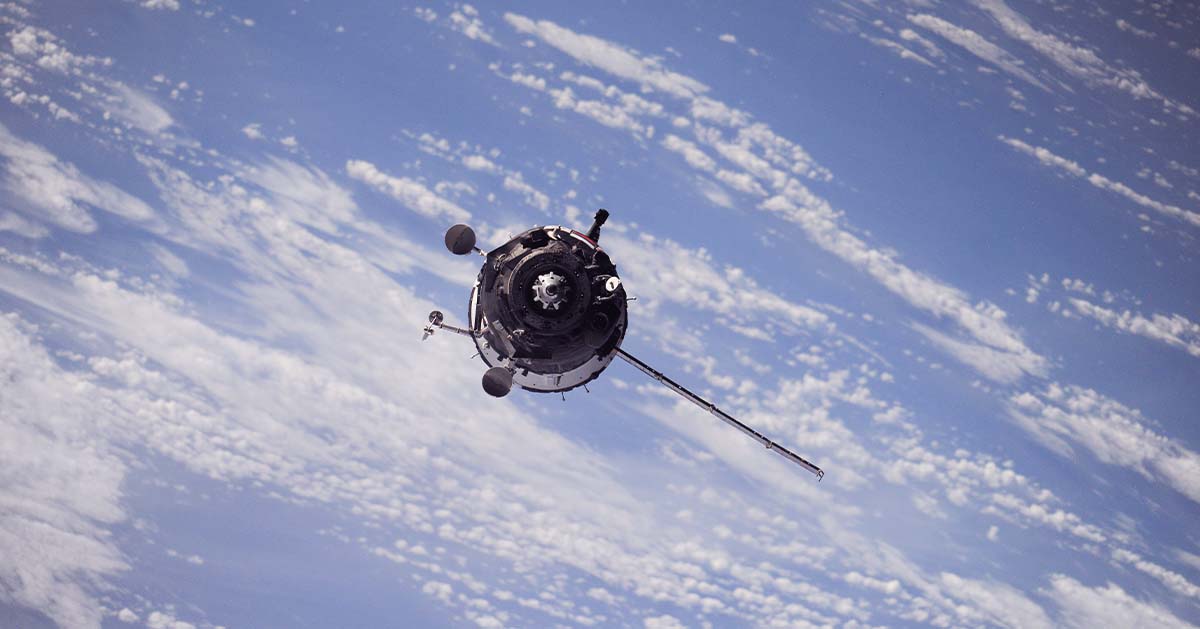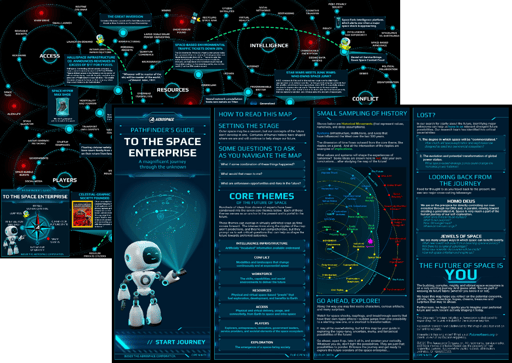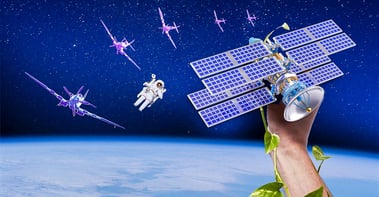Kara Cunzeman from Aerospace Corporation was a guest on our Innovation Rockstars Podcast. In the interview, she emphasizes how important the ability to dream and envision is for successful strategic foresight.
There is movement in the space industry: The goal of flying to Mars and colonizing it is getting closer. Video games like "Surviving Mars" (Haemimont Games) have already picked up on this trend - Kara Cunzeman, Lead Futurist at the Center for Space Policy and Strategy at The Aerospace Corporation spoke to us about the future of mankind in space and the role of strategic foresight. With her team, Kara has set herself the goal of transforming the ecosystem of aerospace companies.
The Aerospace Corporation is an American nonprofit corporation that operates a federally funded research and development center headquartered in El Segundo, California. The corporation provides technical guidance and advice on all aspects of space missions to military, civil, and commercial customers. In our interview, Kara Cunzeman gives us an insight into the development and use of various tools that she has (co-)developed and already put to use during her time at Aerospace.
 The whole podcast episode is also available on Spotify and Apple Podcast or as Video.
The whole podcast episode is also available on Spotify and Apple Podcast or as Video.
The very beginning of strategic foresight at aerospace
Today, Strategic Foresight is one of the most important components of Aerospace. But this has not always been the case: When Kara was hired by Aerospace 6 years ago, she was looking for new methods to increase the knowledge in the company. It took almost 2 years until Kara found the methods she needed. At that time she was working on a new internal project. Its project manager encouraged Kara to visit the Institute For The Future (IFTF). That was the place where Kara experienced the famous "aha" moment when the question suddenly arose: "Does your organization actually keep a regular lookout for signals?". While many of the participants raised their hands to agree to that question, Kara had to lower hers: At Aerospace they did not consciously use such techniques. At the IFTF, she discovered that there were better ways to have an impact on corporate knowledge than Aerospace had been using up to that point. Kara believed that they could make better decisions with these methods. She was so convinced of the IFTF's approach that she trained as a Certified Futures Foresight Practitioner. Kara describes the time after that as a self-starter: She took her knowledge with her into the projects and the new methods established themselves in the company.
COVID-19: Black Swan or Wake-Up-Call?
On the stock market, the term "black swan" refers to an event that causes share prices to plummet as if from nowhere, but which is very understandable in retrospect. The COVID-19 pandemic is also considered by many to be such a "black swan" event. Kara Cunzeman sees it differently, however, and calls the pandemic the ultimate wake-up call:
Those who do not act now, never act.
There have always been pandemics: However, it was not foreseeable that a pandemic would have the same impact as COVID-19 does. But those who recognized the signals before the crisis could prepare themselves. And it is precisely because of these signals, which definitely existed in advance, that we cannot speak of a "black swan" in the case of COVID-19, explains Kara. In her opinion by calling it a "Black Swan" leaders are avoiding taking any responsibility, as the "Black Swan" definition is an unforeseeable event.
Instead of resting on the impossible, companies should conduct continuous risk analysis, evaluate and prioritize. By asking themselves how likely is it that a scenario will occur, companies can assess relevance and allocate resources to prepare their organization for the risks. Unexpected events might happen, but will no longer be surprises.
We have a systematic myopia.
The biggest obstacle in this approach is deeply rooted in ourselves: Our brains are naturally connected in such a way that we prefer to react rather than act. Against that background, Kara advises us to make a conscious decision to act. Only then will we become the leaders of our own evolution.
The correct application of strategic foresight
Many companies believe that they are using the Strategic Foresight methods when they are actually dealing with "Tactical Reactionary Planning" explains Kara. Many people misinterpret the term Strategic Foresight. It is not just about planning scenarios, but rather about using methods that prepare a company for the future. It's a myth that Strategic Foresight is able to predict future events - instead, it uses insights that enable management to make informed decisions.
Strategic Foresight is a conscious decision - again, the reason for this lies in our brains. We live in the here and now - tomorrow is irrelevant for our brain. The caveman in front of the campfire, does not think about what will be tomorrow. Instead, our brain reacts to any current threat. During the reaction moment conscious decisions are not possible, the caveman can only make conscious decisions again when the threat has been eliminated. In order to successfully manage crises, this one-sided mindset must be broken. Only then we are able to open our eyes to the future.
One eye-opener situation is the corona pandemic: The pandemic shows us where our own weaknesses lie. Kara Cunzeman believes that we should address these weaknesses. In order to face crisis like the corona pandemic companies can't sit on their laurels, instead of that they need to take action.
The push-pull model in strategic foresight
Everett S. Lee's push-pull model is in harmony with reacting and acting. Push in this context stands for reacting, which is the standard setting of our brain, therefore to be "pushed away" from an area is easy. On the other hand acting is the pull, which means migrating to another area. It is negatively influenced by the natural inertia of humans and our risk aversion.
Therefore, it is easy to be pushed out of one's own position on the market; it is difficult to take up a new position by pull. Kara explains that every decision reacts to a push, but transformations only occur if we concentrate on the pull.
In order to do so companies need to expand their mindset. What you cannot dream and imagine cannot become real. Instead of looking only at what will happen, you should think about what could happen. Stretching the mindset requires time and opportunities for creative exchange. External perspectives can be fruitful. The lonely chamber, on the other hand, has a destructive effect on creative exchange.
The pathfinder’s guide to the space enterprise
With the Pathfinder’s Guide to the Space Enterprise, Kara and her team developed a poster-sized Future's Map that is freely available on the Internet. Kara and her team spent a whole week in a secluded room. During this time they worked exclusively on the map. Hundreds of ideas from dozens of experts have been condensed into seven core themes which now serve as an anchor to the present and a portal to the future:
- Intelligence Infrastructure: Artificially “incubated” information available on-demand
- Conflict: Modalities and landscapes that change continuously and at exponential speed
- Workforce: The skills, capabilities and social environments to deliver the future
- Resources: Physical and virtual space-based “jewels” that fuel exploration, development, and benefits to earth
- Access: Physical and virtual delivery, usage, and connectivity, from earth to space and intra-space
- Players: Explorers, entrepreneurs, innovators, government leaders, service providers, and societal elements of the space ecosystem
- Exploration: The emergence of a space-faring society
The Future's Map allows spinning ideas and insights on various dimensions of our future in space, such as the question, what kind of people will work in space? Kara's vision is to bring the map on the wall in as many offices as possible to actively support and promote exactly this spinning of ideas and scenarios.
3 valuable tips for the future
Fortunately for the space industry, COVID-19 has had only little impact on the industry so far. The investors continue to support the projects, the research has not been stopped. Kara Cunzeman, on the other hand, is worried about external influences, e.g. through subsidies. At present, however, the future looks rosy.
Finally, she gave us 3 valuable tips that we should all take to heart - now and in the future:
- Strategic Foresight: Use Strategic Foresight actively to prepare yourself and your company for risks.
- Treat the available resources with the respect they deserve. Because we are all made of stardust, here on earth and in space. We will take the problems of the earth with us into space. It is an illusion to be able to restart from scratch in space. That is why Kara appeals to us not to make the same mistakes in space as on earth.
- Change of perspective: Change your perspective from time to time! Astronauts regularly return from a space expedition and report that they now see the world with different eyes. Let's join them and consider our home as the treasure it is for us human beings. If we act now, we can create a world where humans can live in a world of abundance.
We have to treat space as a natural resource.
Many thanks to Kara Cunzeman for this intergalactic interview.
 Kara Cunzeman is a senior project leader for strategic foresight for the Center for Space Policy and Strategy at The Aerospace Corporation. In her role, Kara is focused on cultivating a formalized approach to futures thinking at Aerospace through the strategic foresight Corporate Strategic Initiative (CSI), helping the enterprise adequately prepare its organizations and capabilities to proactively shape the future through innovative approaches across strategy, acquisition, science and technology portfolio management, policy, and operations.
Kara Cunzeman is a senior project leader for strategic foresight for the Center for Space Policy and Strategy at The Aerospace Corporation. In her role, Kara is focused on cultivating a formalized approach to futures thinking at Aerospace through the strategic foresight Corporate Strategic Initiative (CSI), helping the enterprise adequately prepare its organizations and capabilities to proactively shape the future through innovative approaches across strategy, acquisition, science and technology portfolio management, policy, and operations.



/Assets%20and%20Heros/nav-thumbnail-Gartner.webp?width=150&name=nav-thumbnail-Gartner.webp)








